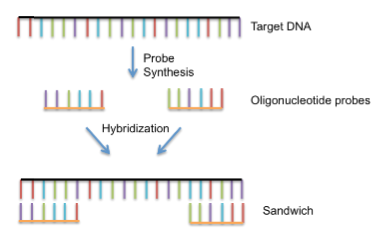Sandwich DNA/RNA hybridization is a technique designed for the detection and quantitation of nucleic acids within crude biological samples. DNA/RNA sandwich hybridization has also widely been used not only to identify a specific DNA/RNA sequence, but also to distinguish single nucleotide polymorphisms (SNPs) between wild-type and mutant DNA/RNA.
The vision of a cheese sandwich is actually quite useful when trying to understand the sandwich DNA/RNA hybridization technique. In this analogy, the cheese represents the single strand (ss) target DNA or RNA, while the bread represents the oligonucleotide probes. For each target nucleotide there are two oligonucleotide probes which are synthesized to be perfectly complementary to the ends of the target ssDNA or RNA. Therefore, during an incubation period each oligonucleotide probe will bind to its specific end of the target nucleotide, one at the 5’ end and one at the 3’ end.
The use of magnetic beads has further enhanced that efficiency, convenience, and specificity of the sandwich technique. The perks of magnetic DNA/RNA hybridization lie in its simplified techniques, low costs, and high selectivity. In short, magnetic DNA/RNA hybridization techniques are as follows: quantification of DNA or RNA within a sample is based on the detection of hybridization events between two specific oligonucleotide probes and the target nucleic acids. The “capture” probe is used to immobilize the target sequence on a solid support, facilitated through the utilization of magnetic nanoparticles (MNP) , where the “detection” probe labels the MNP-capture probe complex with a detectable marker.
Magnetic DNA/RNA Hybridization is a Two-Step Process
Sandwich DNA/RNA hybridization is not very useful unless there is a way to detect that it has occurred. This is where magnetic nanoparticles come in. In step one, the capture oligonucleotide probes are conjugated to the surfaces of these polymer-coated magnetic particles by taking advantage of free amine groups and electrostatic interactions. The second step involves conjugating the MNP-capture probe constructs with the detection probe, whose purpose is to help facilitate quantification of the reaction. The detection oligonucleotide probe can be conjugated to a variety of objects including polymer nanoparticles, fluorescent probes, quantum dots, and even nanorattles. The detection probe used, ultimately, depends on the goal of the assay.
One of the biggest benefits of magnetic DNA/RNA hybridization are in the use of polymer-coated magnetic nanoparticles that allow for many probes to be conjugated to in tandem. This means that multiple target DNA and RNA targets can bind to a single magnetic nanoparticle, to allow for a higher concentrated highly pure product, which is useful when characterizing a diluted or fragile sample. Additionally, fluorescent tags, quantum dots, or nanorattles (raman spectroscopy) are all different techniques for achieving real time quantitative measurements of the hybridization process. This is extremely useful for designing point of care (POC) in vitro diagnostic (IVD) systems for the detection of disease or infection.

The magnetic nanoparticles, once hybridized with the target DNA, can be collected by magnetic separation, but can also be detected by a μNMR device. However, detection based on the magnetic nanoparticle alone is limited. This is why detection oligonucleotide probes can are used, specifically to improve the quantitative detection of the DNA/RNA hybridization reaction.
The General Workflow of Magnetic DNA/RNA Hybridization Using Fluorescent Detectionhe
The other oligonucleotide probe can be conjugated to a variety of objects: polymer nanoparticles, fluorescent probes, quantum dots, nanorattles. The object used depends on the goal of the assay.
The benefit of a polymer nanoparticle is that many probes can be conjugated to it at once. This means that multiple target DNA’s can bind to a single particle and become more concentrated, which is useful when characterizing a diluted or fragile sample.
The fluorescent tags, quantum dots, and nanorattles (raman spectroscopy) are all different techniques for achieving real time quantitative measurements of the hybridization process. This is extremely useful for designing point of care (POC) in vitro diagnostic (IVD) systems for the detection disease or infection.
The workflow for a POC diagnostic would proceed as follows:
- Design oligonucleotide probes to match target DNA.

- Conjugate one probe to magnetic nanoparticles.

- Conjugate the other probe to a fluorescent tag.

- Incubate the probes with the sample. If the target DNA is present then hybridization will occur.

- Magnetic separation techniques are then used to collect the magnetic nanoparticles. Next, analyze the sample using a fluorometer or spectrophotometer.
- Upon analysis, A fluorescent signal will be detected if the target DNA is present in the sample. If there is no target DNA in the sample then no fluorescent signal will be detected. Additionally, quantification of the magnetic DNA/RNA hybridization reaction will be linearly correlated to the emitted fluorescence of the sample..
Related news
- Using magnetic nanoparticles for molecular diagnosis of S. aureus
- Recent advances in protein purification using biomagnetic separation - Part 2
- Recent advances in protein purification using biomagnetic separation
Published on September 01, 2016 and updated on February 08, 2024.




